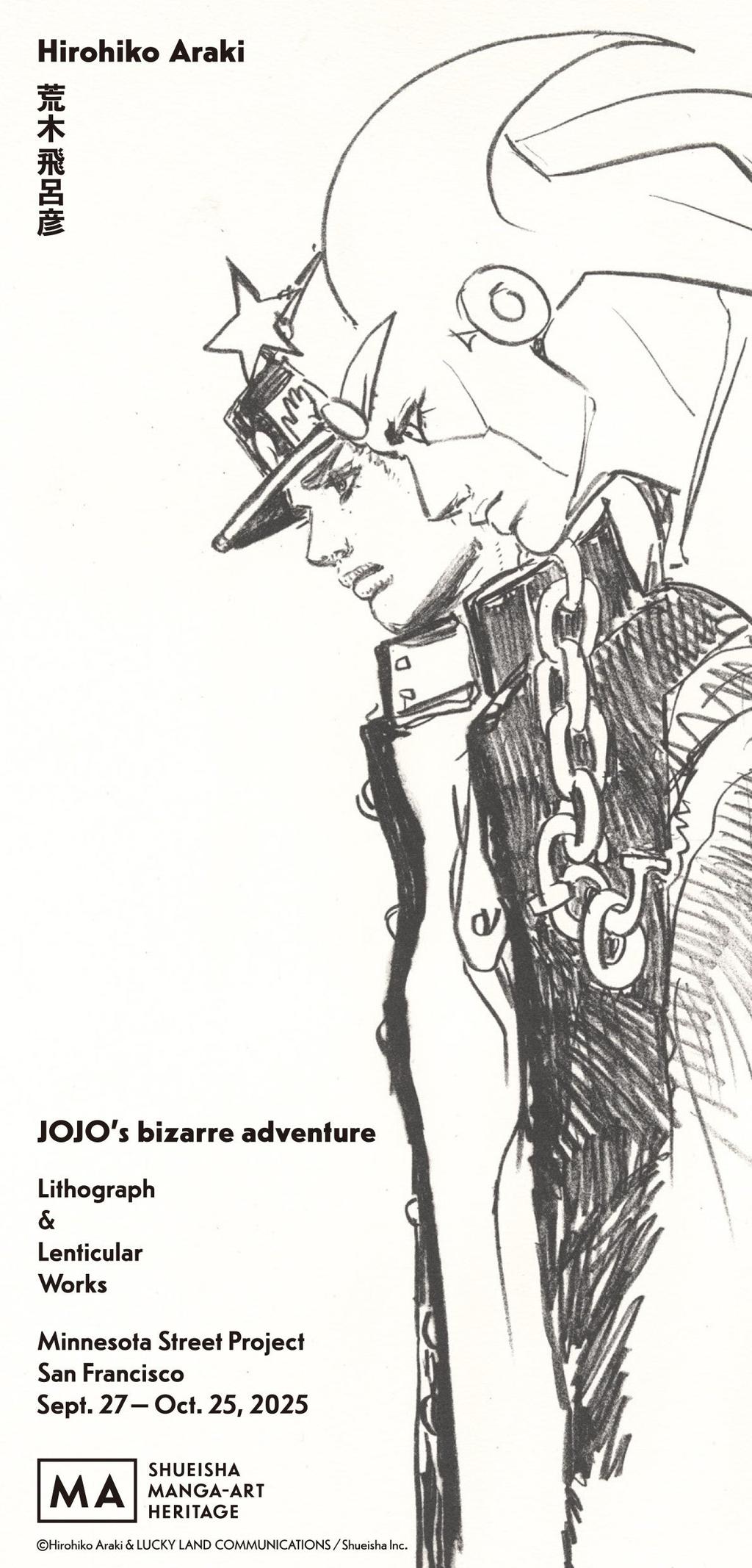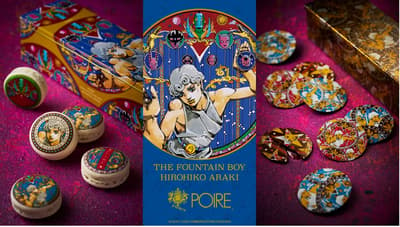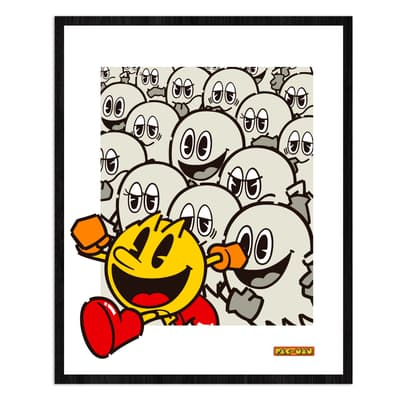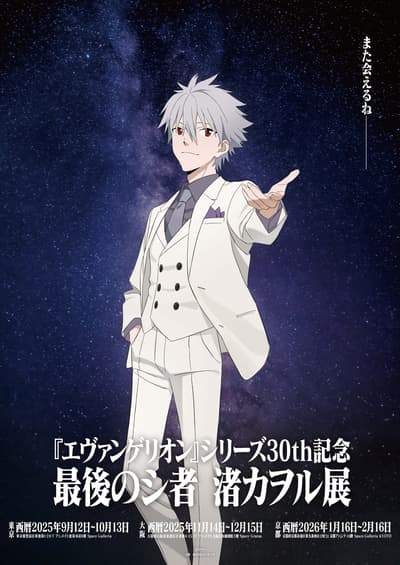A highly anticipated traveling exhibition featuring Hirohiko Araki's "JoJo's Bizarre Adventure" is set to open at Minnesota Street Project in San Francisco this fall. The exhibition showcases the renowned manga artist's first venture into lithograph prints alongside stunning lenticular works that bring beloved characters to life in new dimensions.
Lithograph Works
Beginning in June 2025, Hirohiko Araki embarked on creating nine exquisite lithograph print works.
Lithography is a printmaking technique with over 200 years of history. As the Japanese translation "stone print" suggests, it began as a technique for printing images drawn on stone onto paper. Unlike etching (copper plate engraving) which requires advanced technical skills from artists, lithography is technically easier for reproducing images, leading to its use as an industrial technique. From the 19th century onwards, artists like Edgar Degas (1834–1917) took notice and collaborated with printers to create unique printworks that could only be made using this technique, leading to its recognition as fine art.
While current printing methods involve photographing or scanning original artwork to create printing plates, lithography involves artists drawing images directly onto the plate. Although metal plates are now more commonly used instead of stone, the fundamental principle of artists drawing images directly onto the plate remains unchanged. Therefore, images drawn with lithographic pencils and chalk are transferred to paper with a texture as if drawn directly on paper.
Hirohiko Araki's "JoJo's Bizarre Adventure" began serialization in "Weekly Shonen Jump" in 1986. Currently, the ninth part, "The JOJOLands," is being serialized in "Ultra Jump." The "Hamon = Stand" that appears in Part 3 "Stardust Crusaders" always accompanies (Stand by Me) and fights alongside its user. These Stand forms can take various shapes - sometimes resembling humans, sometimes liquids, gases, or machines.
For his first lithograph works, Hirohiko Araki chose the following characters and their Stands:
- Jotaro Kujo/Star Platinum
- DIO/The World
- Josuke Higashikata/Crazy Diamond
- Giorno Giovanna/Gold Experience
- Jolyne Cujoh/Stone Free
- Funny Valentine/D4C (Dirty Deeds Done Dirt Cheap)
- Rohan Kishibe/Heaven's Door
- Yasuho Hirose/Paisley Park
- Dragona Joestar/Smooth Operators
Typically, manga text is drawn in monochrome. These drawings are converted into clear black and white binary data during the plate-making process and printed using letterpress rotary printing. This means that the gradations of pencil and ink are not reproduced.
In these works, lithographic pencils and chalk were used, allowing the artist's drawn lines to be reproduced exactly as drawn. Since lines cannot be erased with erasers once drawn, artists must work with tension. In return, we can feel the robustness of leisurely extending lines, the accuracy and comfort of cleanly drawn lines, and the rhythm of roughly drawn shadows.
Printmaking was handled by Satoru Itatsu (Zenpukuji Lithograph Workshop). Nine works, 100 copies each, were produced.
Lenticular Works
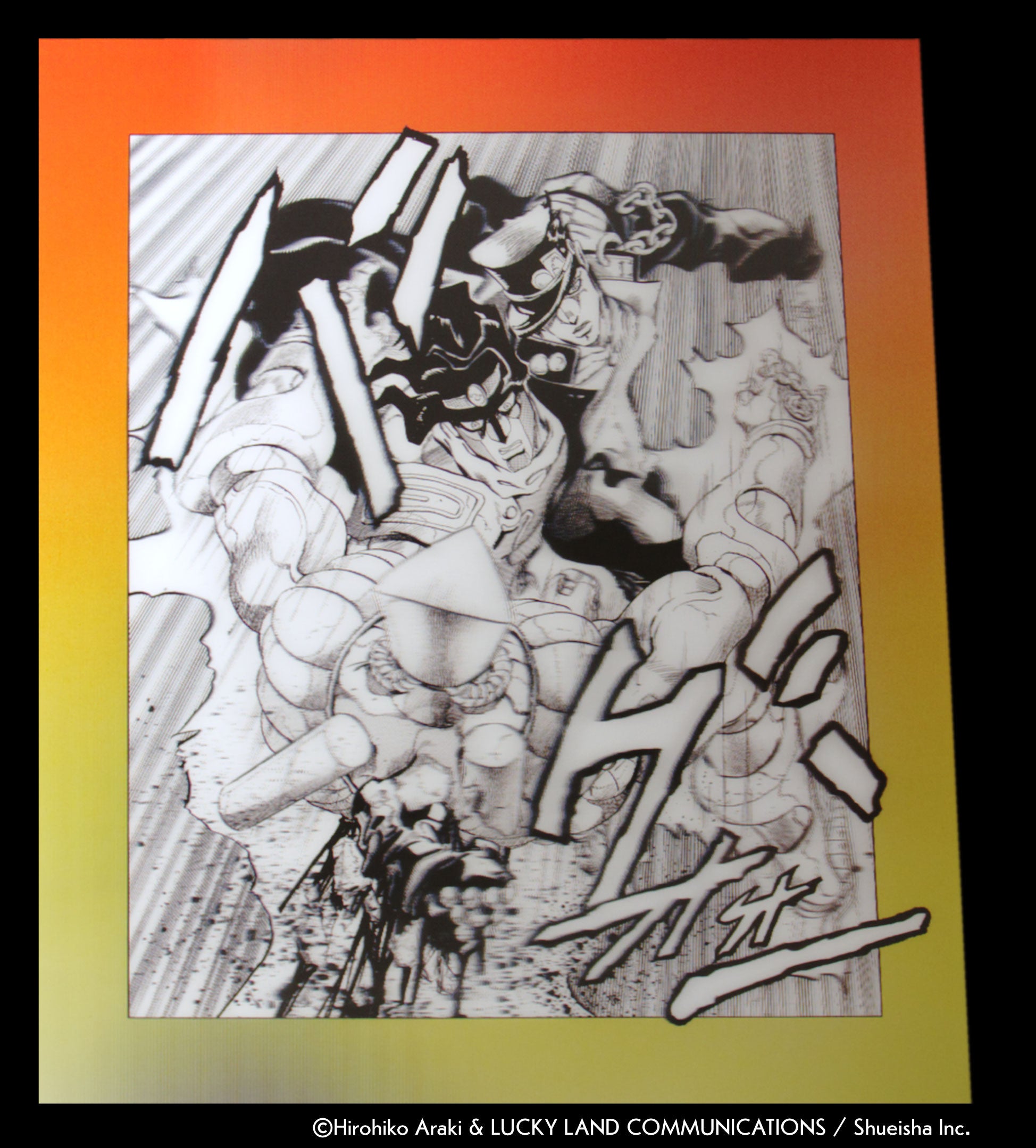
Lenticular printing is a printing technique that uses sheet-like "lenticular lenses" to animate images or make them appear three-dimensional. These works employ the technique of making images appear three-dimensional.
Lenticular printing that achieves stereoscopic vision by utilizing the parallax between human eyes cannot reproduce its effect through single-lens camera photography. It manifests its maximum effect only when viewed with both human eyes. This technology, known as a parallax barrier, has over 100 years of history. Records show it was patented in the United States in 1915, and a studio offering 3D lenticular printing services opened in Paris in the 1940s. Mass production of color lenticular prints became possible in the 1960s, gaining explosive popularity. While many were made as souvenirs like postcards, the ability to create large-format prints also led to their use in fine art print works.
This time, impressive scenes of protagonists from Parts 1-9 were created as works approximately one meter wide.
- Part 1: Jonathan Joestar
- Part 2: Joseph Joestar
- Part 3: Jotaro Kujo/Star Platinum
- Part 4: Josuke Higashikata/Crazy Diamond
- Part 5: Giorno Giovanna/Gold Experience
- Part 6: Jolyne Cujoh/Stone Free & Ermes Costello/Kiss
- Part 7: Johnny Joestar/Tusk ACT4
- Part 8: Josuke Higashikata/Soft & Wet
- Part 9: Jodio Joestar/November Rain
Moving closer, farther away, and walking left and right, viewers can appreciate scenes that should be moments in expanded time. This should provide a new experience combining the manga expression format with lenticular printing techniques.
Following the San Francisco showcase, the exhibition will continue its journey to Kyoto for a special three-day presentation.
Kyoto Exhibition
Hirohiko Araki "JoJo's Bizarre Adventure": Lithograph & Lenticular Works
Kyoto Exhibition
Location: Higashi Hongan-ji Temple, Hakushoin (Kyoto)
Dates: November 14-16, 2025 (Friday to Sunday)
Tickets: Adults ¥1,800 | Junior/Senior High School Students ¥1,200
Important: This exhibition operates on a complete reservation system. Ticket sales begin September 9, 2025 at 1:00 PM JST. Advance booking is required through the official ticketing site.
Exhibition Details
Hirohiko Araki "JoJo's Bizarre Adventure": Lithograph & Lenticular Works
Dates: September 27 - October 25, 2025 (Closed Sundays and Mondays)
Location: Minnesota Street Project
Address: 1275 Minnesota St. and 1150 25th St., San Francisco, California 94107, USA
Website: https://minnesotastreetproject.com/
About Minnesota Street Project
Minnesota Street Project is a unique cultural destination located south of San Francisco. This renovated warehouse complex, which opened in 2016, houses multiple galleries, artist studios, and restaurants. The exhibition will take place in the venue's central space, alongside Keiichi Tanaami's concurrent "TANAAMI!! AKATSUKA!!" exhibition.
About the Artist
Hirohiko Araki was born on June 7, 1960, in Miyagi Prefecture, Japan. His journey to manga stardom began in 1980 when "Poker Under Arms" earned a runner-up prize in the prestigious 20th Tezuka Award, leading to his debut in "Weekly Shonen Jump."
The launch of "JoJo's Bizarre Adventure" in 1986 would prove to be a cultural phenomenon. The series has achieved remarkable success with domestic circulation exceeding 120 million copies. Currently, Araki continues to captivate readers with "The JOJOLands," the ninth part of the saga, serialized in "Ultra Jump."
Araki's artistic prowess has transcended manga boundaries. His 2009 participation in a Louvre Museum exhibition, featuring "Rohan at the Louvre" (Rohan au Louvre), marked a significant milestone. Global recognition followed in 2013 when his collaboration works were displayed in GUCCI stores worldwide. The 2018 "Hirohiko Araki Original Art Exhibition JOJO - Adventure's Ripple" at Tokyo's National Art Center broke new ground as the first individual exhibition by an active manga artist at a national art museum.
For more information about this exhibition and future releases, visit the Shueisha Manga Art Heritage website.
